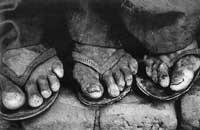Garbage: a really ‘global’ problem
Until a few decades ago, household waste was used to feed cattle or to fertilize the soil. The rest was simply poured into the river, the sea, the surface or the bottom of the earth, but since they were normally organic waste, they decomposed and returned to the cycle of nature. This is what is still being done in small rural municipalities.

In most places, however, the Earth has lost the ability to assimilate all the residues abandoned by man. On the one hand, the population has grown spectacularly and, on the other hand, the growth of cities, technological development, industrial activities and new consumption habits have contributed to the production of much more waste. For example, in the past, sustainability was taken into account when developing instruments. At present the slogan ‘use and pull’ has been extended and many items are sold wrapped in superfluous containers that are thrown directly into the trash.
Thus, in developed countries it is estimated that each inhabitant generates every day one kilo of waste, while 30 years ago they were emitted between 200 and 500 grams. In any case, the problem is not only quantity, but also quality or composition, which if before it was compact and almost totally organic, now acquires a much larger volume, is not totally biodegradable and is increasingly toxic
The main solution that has been given to urban waste has been the landfill deposit. This causes a series of damages, among which are the risk of contamination of the underground waters, the microorganisms and zones conducive to the cultivation of rats that are source of diseases, the deterioration of the landscape and the generation of bad smells, which show the separation between the citizenship, when always selecting the poorest areas for the installation of landfills.
In developing countries, having not developed a proper waste collection and treatment system, the problem is even more serious. For example, in the Indian capital, New Delhi, garbage accumulates in places that were formerly green areas. 13 million inhabitants of the city generate eight thousand tons of waste, but urban services can store less than half. The rest remains anywhere, so there are dangerous outbreaks of infection. Among the dirtiest cities in the world are Cairo, Bangkok and Mexico City.
Looking for solutions

Decades ago, industrialized countries appropriated the problem. Since then, ways have been opened to give a solution. For example, incineration plants reduce waste space, in fact they decrease by 90%. However, the risk of involvement in health and the environment does not go away.
Other ways require the participation of consumers and more and more people are in charge of separating waste to take it to the recycling containers. Politicians and organizations like the United Nations analyze the issue and propose some changes and measures
However, the problem is at the core of the consumer society, and while production methods and lifestyle do not change, it will be very difficult to find a complete solution.
Landfills in the form of landfills
Landfills not only protect microorganisms and rats, but also shelter thousands of people in landfills, shanty towns with materials collected between the residues and using apparatus found, the landfill being their place of work. In this situation, there is a risk of any catastrophe. More than one thinks in July 2000 near the capital of the Philippines

Unicef has denounced that thousands of children live worldwide in the collection of materials to sell to retailers of the recycling industry, mainly paper, plastics, clothing, crystals and metals. The health of these children is unfortunate, many suffer from scabies, and those who collect crystals and metals are trapped by the cuts that occur in their hands and feet. They increase less than is necessary for overload and often sick from eating food in poor condition.





